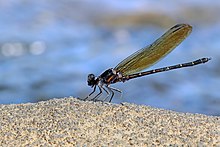| Dysphaea ethela | |
|---|---|

| |
| Male | |

| |
| Female | |
| Conservation status | |
 Least Concern (IUCN 3.1) | |
| Scientific classification | |
| Domain: | Eukaryota |
| Kingdom: | Animalia |
| Phylum: | Arthropoda |
| Class: | Insecta |
| Order: | Odonata |
| Suborder: | Zygoptera |
| Family: | Euphaeidae |
| Genus: | Dysphaea |
| Species: | D. ethela |
| Binomial name | |
| Dysphaea ethela Fraser, 1924 | |
Dysphaea ethela, the black torrent dart, is a species of damselfly in the family Euphaeidae. The insect is named after Frederic Charles Fraser's wife, Ethel Grace Fraser (née Varrall) (1881-1960), a constant companion of his collecting trips in India.
It is found in Karnataka and Kerala and Tamil Nadu in Western Ghats. This species is also known from the Eastern Ghats and central India.
Description
It is a medium sized damselfly with black head and brown-capped pale grey eyes. Its thorax is black, marked with narrow antehumeral and humeral greenish-yellow stripes. There are another yellow stripes on the base of lateral sides. These marks will get obscured by pruinescence in old males. Wings are transparent; but evenly infused with brown. Abdomen is black, marked with yellow apical annules up to segment 8. There are yellow lateral stripes up to segment 6. Anal appendages are black.
Female is short and robust; the yellow marks are more broad and vivid. The yellow lateral stripes continued to segment 7. Segment 8 has a narrow and 9 has a broad yellow apical annule, covering dorsal half.
Habitat
It breeds in streams and rivers. Commonly seen perched on reeds or bushes on the river's bank or settled on rocks far inside the stream.
See also
References
- ^ Dow, R.A. (2019). "Dysphaea ethela". IUCN Red List of Threatened Species. 2019: e.T163734A122208779. doi:10.2305/IUCN.UK.2019-2.RLTS.T163734A122208779.en. Retrieved 19 November 2021.
- ^ C FC Lt. Fraser (1924). A Survey of the Odonate (Dragonfly) Fauna of Western India and Descriptions of Thirty New Species (PDF). pp. 480–481.
- Paulson, D.; Schorr, M.; Abbott, J.; Bota-Sierra, C.; Deliry, C.; Dijkstra, K.-D.; Lozano, F. (2024). "World Odonata List". OdonataCentral, University of Alabama.
- ^ "Dysphaea ethela Fraser, 1924". India Biodiversity Portal. Retrieved 2017-03-07.
- ^ "Dysphaea ethela Fraser, 1924". Odonata of India, v. 1.00. Indian Foundation for Butterflies. Retrieved 2017-03-07.
- Hämäläinen, Matti (2015). "Catalogue of individuals commemorated in the scientific names of extant dragonflies, including lists of all available eponymous species-group and genus-group names" (PDF). International Dragonfly Fund (IDF) - Report. 80: 1–168. ISSN 1435-3393. Retrieved 18 September 2020.
- ^ Subramanian, K. A. (2005). Dragonflies and Damselflies of Peninsular India - A Field Guide.
- K.A., Subramanian; K.G., Emiliyamma; R., Babu; C., Radhakrishnan; S.S., Talmale (2018). Atlas of Odonata (Insecta) of the Western Ghats, India. Zoological Survey of India. pp. 82–83. ISBN 9788181714954.
- ^ C FC Lt. Fraser (1934). The Fauna of British India, including Ceylon and Burma, Odonata Vol. II. Red Lion Court, Fleet Street, London: Taylor and Francis. pp. 92-94.
External links
 Data related to Dysphaea ethela at Wikispecies
Data related to Dysphaea ethela at Wikispecies Media related to Dysphaea ethela at Wikimedia Commons
Media related to Dysphaea ethela at Wikimedia Commons
| Taxon identifiers | |
|---|---|
| Dysphaea ethela | |
This article related to Calopterygoidea is a stub. You can help Misplaced Pages by expanding it. |


